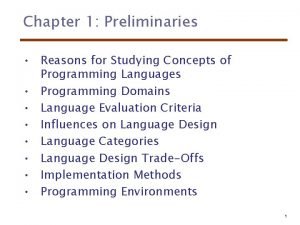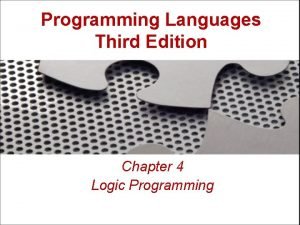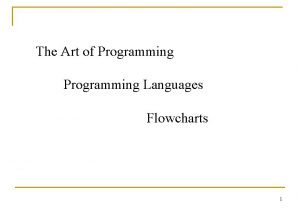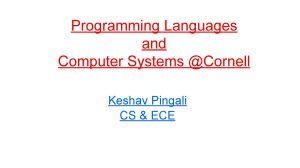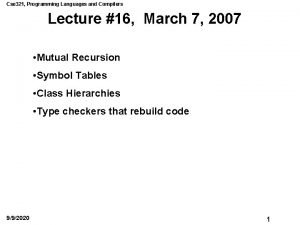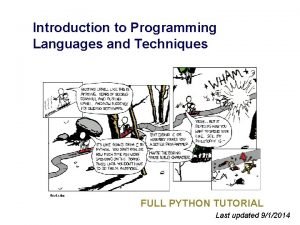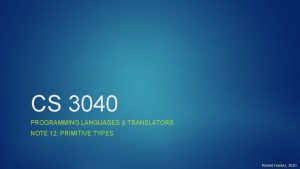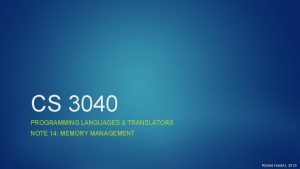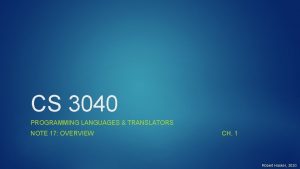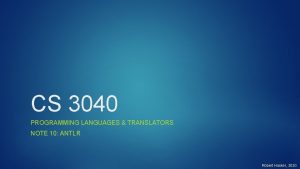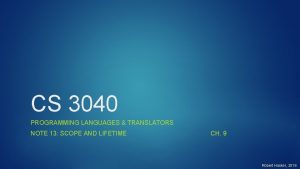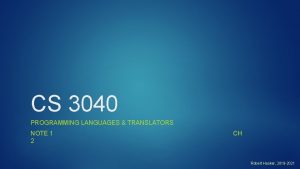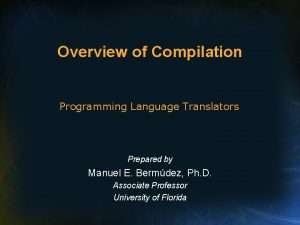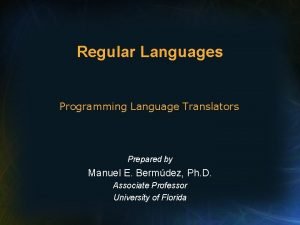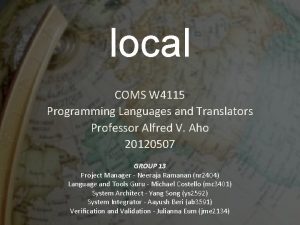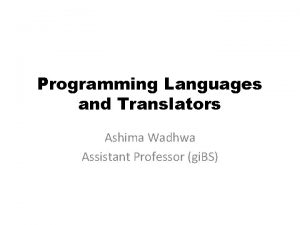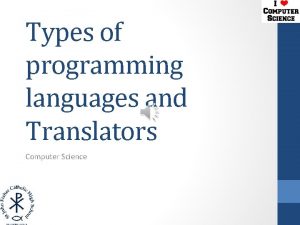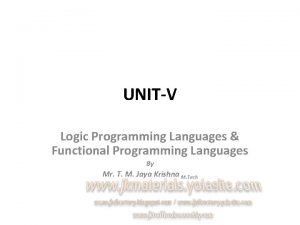CS 3040 PROGRAMMING LANGUAGES TRANSLATORS NOTE 15 COMPILATION





















- Slides: 21

CS 3040 PROGRAMMING LANGUAGES & TRANSLATORS NOTE 15: COMPILATION, TRANSLATION Robert Hasker, 2019

What is my experience Implemented compiler, Hi. C Goal: introductory environment with good error messages Recursive descent parser – simplified error handling Set of classes representing runtime execution Parser: text into a syntax tree Each statement, expression: an eval() operation for that time of element Running a program: executing eval operations until crash or reach end of main

The Problem Start with code: float distance(float x 1, float y 1, float x 2, float y 2) { float delta_x = x 2 – x 1; float delta_y = y 2 – y 1; float dist = sqrt(delta_x * delta_x + delta_y * delta_y); return dist; } Machine needs basic instructions How to get there?

First step: decomposing the program float distance(float x 1, float y 1, float x 2, float y 2) { float delta_x = x 2 – x 1; float delta_y = y 2 – y 1; float dist = sqrt(delta_x * delta_x + delta_y * delta_y); return dist; } That is: generating a parse tree Code structure, syntax errors But then what?

• Identifying tokens Lexical analysis • Removing whitespace Syntactic analysis Architecture of a Compiler: Front End • Parsing • Identifying structure Preprocessing • Lexical analysis: typically regular expressions • Syntactic analysis: CFGs • #define, #include, etc. • Templates Semantic analysis CS 2040 • Identifiers, types, etc.

Program analysis • Analyzing control flow • Identify dead code, errors Large-scale optimization Architecture of a Compiler: Back End • Liveness analysis • Loop optimization • etc. Instruction Selection • Translate to assembly code Peephole optimization • Simplify code like push X pop X Code Generation • Link libraries • Generate final executable

What happens after parse code? Our ANTLR solutions: process each element as it is reduced (popped from the stack and replaced by a nonterminal) This doesn’t scale: large amounts of code in the ANTLR file Better solution: use parse trees Create a tree representing the program Build visitors (the design pattern) to process it Visitor pattern

Visiting graphics Added methods to support various inquiries: area: compute area of graphic - reasonably generalpurpose, though there are lots of ways to compute this all_colors: return set of colors in image - somewhat specialized Visiting parsethe trees says. Hello: does picture contain text "Hello" - very specific to a problem • Tree nodes: expressions, statements, etc. Visit operations: checkers, code generators Issue: adding these • methods makes atype class very specific to a particular problem • Win: visitors separated from the parsing • New machine architecture? Just update the visitor Needed: a way to process all items in hierarchy without class Graphic. Visitor • Preferred of ANTLR: write visitors having to add methods to those use items { • Each parse creates an internal tree, use visitor to process this tree Solution: set up a visitor designed to visit each sort of public: item (but do nothing for each): virtual void visit(Line &) { } virtual void visit(Rectangle &) { } Line: : accept(Graphic. Visitor *gv) { gv->visit(*this); } virtual void visit(Text &) { } Picture: : accept(Grpahic. Visitor *gv) { gv->visit(*this); for(c in children) c. apply(gv); } virtual void visit(Picture &) { } };

Generating code Basic issues Create an intermediate language to avoid being too processor-specific too quickly Must translate the tree generated by the parser into an instruction sequence Will start by translating it to a simpler tree with core instructions Will manipulate these into a canonical form That is, a form in which each expression corresponds to a unique form Will use tiling to map this tree into an instruction sequence Will determine how to maximize registers Last: optimizations Material based on modern compiler implementation in Java Andrew Appel

Intermediate Representation Could go straight to code: difficult to analyze, lots of detail Usual solution: Intermediate representation Expressed as a Haskell Datatype: data Expression = CONST Int -- integer constant | NAME Int -- ref to identified location | TEMP Int -- numbered temporary -- often allocated to a register -- have an infinite number of temporaries | BINOP Char Expression -- apply operator to expressions e 1, e 2 data Statement = MOVE_TEMP Int Expression -- store Expression result at identified temp | MOVE_ADDR Expression -- result of second expr put at addr of first | EVAL Expression -- evaluate expression, discard result | JUMP Expression -- evaluate expr and jump to that address | CJUMP Compare Expression Statement -- use operator to compare expressions | MEM Int -- reference word at given address -- if true: jump to first statement | CALL String [Argument] -- false: jump to second statement -- call named function with argument list | SEQ Statement -- execute s 1 then s 2 -- evaluate arguments left-to-right | LABEL Int -- define label at current address | ESEQ Statement Expression -- eval statement; expression is result -- will use NAME Int to refer to label data Compare = EQ|NE|LT|LE|GT|GE

Examples Code: if ( a < b && c >= d ) {. . . true block with label t } else {. . . false block with label f } x = n + 99; Translate assume x is a global at 17 assume n on stack - local variable 5 assume frame pointer in (TEMP 1) Translation: MOVE_ADDR (NAME 17) Translation, where z is a unique integer (generated for a new label) a, b, c, d are variables 10, 11, 12, 13 SEQ (CJUMP LT (NAME 10) (NAME 11) z f) (SEQ (LABEL z) (BINOP ‘+’ (TEMP 1) (CONST 5)) (CONST 99)) (CJUMP GE (NAME 12) (NAME 13) t f)) Exercises: while loop example, array index example Other constructs: very similar!

• Note there are type issues; treat linearize as pseudocode • Apply linearize until cannot be applied any more • More efficiently: recursively call linearize on each Consider the IR instruction subexpression • Result: all ESEQs. Statement of the form CJUMP Compare Expression Statement ESEQ (SEQ a (SEQ b. . )) e Most architectures: conditional jumps are similar • Can alsotoreorganize CALLs to top level or in MOVE • Can then identify basic blocks, translate any CJUMP into JE Label appropriate machine instructions Conditional jump to specified label if result of last comparison is equal to zero • Why introduce CJUMP? it simplifies the initial translation Can reorganize code into basic blocks Basic Blocks a sequence with no internal jumps linearize (ESEQ s 1 (ESEQ s 2 e)) = ESEQ (SEQ s 1 s 2) e linearize (BINOP op (ESEQ s e 1) e 2) = ESEQ s (BINOP op linearize (BINOP op e 1 (ESEQ s e 2)) | (commutative op) ESEQ s (BINOP linearize (BINOP op e 1 (ESEQ s e 2)) = let t = new. Number in ESEQ (MOV (TEMP t) e 1) (ESEQ s (BINOP op (TEMP linearize x = x -- remaining cases e 1 e 2) = op e 1 e 2) t) e 2))

Generating Machine Code Program: Instruction, Expression tree How to generate code from this? This might be implemented as SEQ MOVE_ADDR MOVE_TEMP 4 CONST 22 12 BINOP NAME ‘*’ NAME TEMP 36 4 mov r 4, #22 ; r 4 = constant 22 mov r 0, @36 ; r 0 = data at addr 36 mul r 0, r 4 ; r 0 = r 0 * r 4 mov @12, r 0 ; M[12] = r 0 Basic idea: map portions of the tree to instructions In some cases, will have multiple instructions for a subtree Instruction selection: match segments of trees to instructions tiling: the process of identifying instructions for each bit of the tree

Sample tiles

Tiling code fragments But this is not the only way! Alternative:

Tiling code fragments What tiling might we prefer? Cost of Maximum Munch: • Letsequence N = number of nodes in tree Best tiling: lowest-cost instruction • K = average number of non-leaf nodes per tile Implies we can assign a cost to each tile • K’ = maximum number of nodes to examine for any tile optimum tiling: sum of tiles is • the possible valuetiles T =lowest number of different • T’ = average number of tiles matching at each node optimal tiling no two adjacent tiles can be • combined tile COST: to (K’create + T’)a. Nlower-cost / K, or O(N) Optimum is often easier to compute than optimal Maximal Munch algorithm: 1. find largest tile fitting root of tree 2. cover root and appropriate children by tile 3. recurse on uncovered children

Actual Instruction Sets Common issue: RISC vs CISC Reduced Instruction Set Computers vs Complex. . . Pentium: six general-purpose registers, sp, fp multiply requires argument to be in eax, result in eax and edx Has side-effect instructions such as autoincrement How to use? Ignore? Match as a special case (ad-hoc)? construct special algorithms? Item RISC CISC registers 32 6, 8, 16 register classes one many; dedicated registers for some ops arithmetic operations register only memory and register (modes) instruction type three address: r 1 <- r 2 op r 3 two address: r 1 <- r 1 op r 2 addressing modes M[reg+const] many instruction one word size • Argument for RISC: complexvariable instructions are difficult to use in compilers auto-increment, others side effects none • Result: few compilers take advantage of the complexity • Solution: maximize registers • keep instructions lightweight and fast • Some architectures: ”register files” that are swapped in and out on calls

Allocating Registers Core issue: all machines have a finite number of registers Key concept: determining where a variable is live That is: where a variable holds a value that may be needed in the future Consider a = 0 // node 1 L 1: b = a + 1 // node 2 c = c + b // node 3 a = b * 2 // node 4 if a < N goto L 1 // node 5 return c // node 6 • Where is b alive? • Where is a alive? • Where is c alive? • The lines: control-flow graph

Allocating Registers Control-flow graph: captures which values cannot be stored in the same register Additional issue: some registers are interdependent Example: Intel imul AX, location multiplies register AX by value at given location, storing result in AX and DX Register allocation: application of graph coloring Graph coloring: assign colors to all nodes such that no two adjacent nodes have the same color use a minimum number of colors Application to register allocation: different colors = different registers need distinct registers for u, v, x, y Can store u, w, z in same register u v w Does this graph require 4 colors? x y z

Allocating Registers Register allocation as graph coloring: different colors represent different registers Issue: graph coloring is NP-Complete All known algorithms take exponential time If have N values and k registers, must try k. N possible allocations Eg: 20 variables, 10 registers, then 1020 possibilities! Being NP-Complete means that it shares this exponential time behavior with many other problems That is, there a large group of problems that also seem to take exponential time We do not know if there is a polynomial time solution! However, people have tried for 50 -60 years and haven’t found one yet. . . Approximate algorithms: see compiler construction textbook Typically: use up all available registers, then start storing registers on stack as need new ones See Appel’s book. . . Now ready to build full, non-optimizing compiler! This is left as an exercise. . .

Review Compilation: translating code from source form to executable binaries Intermediate representation: easy to generate from parse trees, easy to translate to actual instructions Basic blocks: sequences with no embedded branches These are important to many optimizations Tiling: fitting instructions to intermediate representation maximal munch: optimum, but possibly not optimal RISC vs CISC Allocating registers as a form of graph coloring
 Translators and facilities of languages
Translators and facilities of languages Translators
Translators Infinisource fsa
Infinisource fsa Naga 3030
Naga 3030 Hpe storeever msl6480 tape library
Hpe storeever msl6480 tape library Real-time systems and programming languages
Real-time systems and programming languages Plc
Plc Reasons for studying concepts of programming languages
Reasons for studying concepts of programming languages Programing languages
Programing languages Transmission programming languages
Transmission programming languages Types of programming languages
Types of programming languages The art of programming language
The art of programming language Multithreading program in java
Multithreading program in java Attribute grammar in principles of programming languages
Attribute grammar in principles of programming languages Advantages of application software
Advantages of application software Joey paquet
Joey paquet Cornell programming languages
Cornell programming languages Programming languages
Programming languages Cse 340 principles of programming languages
Cse 340 principles of programming languages Cs 421 programming languages and compilers
Cs 421 programming languages and compilers Cxc it
Cxc it High level languages
High level languages







